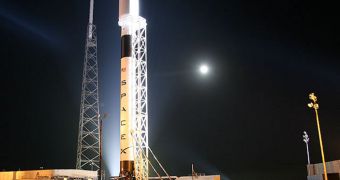Today, December 3, the private company Space Exploration Technologies Corporation (SpaceX) will be broadcasting a webcast showing a critical static test fire of the engines on its Falcon 9 medium-lift delivery system.
This assessment is of critical important for the company, which is currently getting ready to launch its first unmanned Dragon space capsule to space. Take-off is planned for a December 7-9 launch window.
Officials at SpaceX says that the static firing is a critical component of the full launch dress rehearsal that the corporation is currently carrying out at Space Launch Complex 40, the Cape Canaveral Air Force Station (CCAFS) pad that it uses to launch its rocket.
The webcast showing the nine Merlin engines on the Falcon 9 roaring to life will begin at 8:00 am EST / 5:00 am PST. The actual tests are scheduled to start at 9 am EST / 6 am PST.
It is absolutely critical for the company to nail this test right. Under the provisions of the $1.3 billion Commercial Orbital Transportation Services (COTS) contract it signed with NASA, it needs to conduct the first Dragon test flight this year.
If the launch remains a go for December 7 as planned, then we will witness the first-ever flight carried out under the COTS initiative, which seeks to encourage the private space industry.
The program was developed at the American space agency due to the retirement of the three remaining space shuttles, which will leave the country without manned orbital capabilities for the first time ever.
Hopes are high among government and NASA officials that the private sector will come through for the US, if given sufficient funding. SpaceX and Orbital Sciences Corporation have until now been the main beneficiaries of COTS funding.
The main objective for this support initiative is the development of a spacecraft that is capable of transporting supplies to the International Space Station (ISS). SpaceX developed Dragon for this very purpose.
As such, during the December 7 test flight, the Falcon 9 rocket will have to take off successfully, reach orbit, and eject the space capsule. Dragon will then have to conduct at least 4 orbits around Earth.
During this time, mission controllers will send a variety of commands, and will instruct the spacecraft to perform a large number of maneuvers. The goal of this is to test the functional of all systems,
After the orbital stage of the mission is complete, the capsule will need to reenter Earth's atmosphere without burning up, and then landing softly via the aid of parachutes into the ocean.
NASA will allow SpaceX to move to the next stages of the COTS agreement only if all these conditions are satisfied. The static test fire will be transmitted on the SpaceX website, SpaceRef reports.

 14 DAY TRIAL //
14 DAY TRIAL //